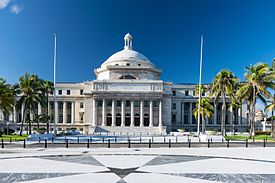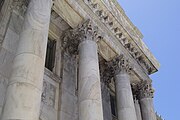Capitol of Puerto Rico
| Capitol of Puerto Rico | |
|---|---|
Capitolio de Puerto Rico | |
North façade of El Capitolio from Plaza San Juan Bautista through Plaza de la Democracia | |
 Interactive | |
| Alternative names | El Capitolio Casa de las Leyes Palacio de las Leyes |
| General information | |
| Type | Legislature |
| Architectural style | Neoclassical, Beaux-Arts architecture |
| Location | Avenida Ponce de León and Avenida Muñoz Rivera, San Juan, Puerto Rico |
| Address | 1 Plaza de la Democracia, San Juan, PR, 00901 |
| Coordinates | 18°28′1″N 66°6′21″W / 18.46694°N 66.10583°W |
| Construction started | 1921 |
| Completed | 1929 |
| Inaugurated | February 11, 1929 |
| Design and construction | |
| Architect(s) | Rafael Carmoega |
| Official name | El Capitolio de Puerto Rico[1] |
| Designated | November 18, 1977 |
| Reference no. | 77001555[2] |
The Capitol of Puerto Rico (Spanish: Capitolio de Puerto Rico), also known as Casa de las Leyes (House of Laws), and most commonly referred to as El Capitolio (The Capitol), is the seat of the Legislative Assembly, or the bicameral legislature, composed of the Senate and House of Representatives, responsible for the legislative branch of the government of Puerto Rico. Located on San Juan Islet immediately outside the Walls of Old San Juan, the oceanfront, neoclassical Beaux-Arts-style, entirely white marble-covered edifice was constructed between 1921 and 1929 to resemble the ancient Roman Pantheon in Rome, using as inspiration the Low Memorial Library in New York City. It was added to the National Register of Historic Places in 1977.[3][4][5]
History
[edit]
Prior to the establishment of the Capitol, the Legislative Assembly used the Provincial Delegation Building, which now houses the Department of State.[6] The idea of constructing a capitol was first introduced by former Resident Commissioner Luis Muñoz Rivera in 1907, and was partly meant to demonstrate some degree of civilian rule in the island, which at the time was already a colony of the United States.[7] The project proposed by Muñoz Rivera assigned $3 million for the construction and established rules for a contest among architectures to decide which one would do the work.
In September 1907, Commissioner of the Interior Laurence Grahame sent the official request for architects through the press and magazines of United States. The specifications for the building were that it was supposed to have three principal installations: the Executive Council, the House of Delegates, and the Supreme Court. It was supposed to be simple, conservative, and appropriate to the island's weather conditions. 134 architectural designs were submitted from the US, Cuba, Canada, France, Spain, and Puerto Rico.
The evaluation of the proposals was in charge of William F. Willoughby (president of the Executive Council), José de Diego (Speaker of the House, represented by Luis Muñoz Rivera), José S. Quiñones (President of the Supreme Court), and Laurence Grahame. Three American architects were also asked to join the commission: E.B. Homerde, John E. Howe, and Bowen Bancroft Smith. In the end, three projects were selected, belonging to Frank E. Perkins (New York City), James H. Ritchie and Lewis B. Abbot (Boston), and Henry L. Beadle (New York).

Finally, the project chosen was the one from Frank E. Perkins, which presented a neoclassical style with little ornamentation. The main halls were organized around a central patio, with the south facade leading to the lobby. The lobby had the dome above, which bore a style similar to the Pantheon in Rome, including the oculus. To the right, there would be a session hall for the Executive Council, and to the left one for the House of Delegates. The Supreme Court would meet in a hall facing north.

However, Luis Muñoz Rivera and the local press preferred another project that was disqualified by the evaluating committee, because the architect had included a slogan in the blueprints, which was forbidden. The project belonged to a Puerto Rican engineer called Carlos del Valle Zeno. Del Valle's project presented a Renaissance style, with neoclassic orders.
Despite public opinion, Perkins was hired to make the construction blueprints for the Capitol, which were then auctioned. It wasn't until 1920 that the project was retaken when the Commissioner of the Interior, Guillermo Esteves, published a new design. The change came after a revision from the Department of Interior, which found Perkins' design to be inappropriate. With the supervision of architects Adrian C. Finlayson, Francisco Roldán, and Pedro de Castro, new blueprints were made using the Renaissance style.

Construction of the building eventually began in 1921 under the leadership of Antonio R. Barceló. However, construction was halted after completion of the first level. When Finlayson got ill, he was replaced by Rafael Carmoega who, along with architects Joseph O'Kelly, William Schimmelpfennig, Harry Pembleton, Albert Nichols, Luis F. Pina, and Gonzalo Fernós Maldonado, made another design to finish the structure.
Their design incorporated some of the elements from Perkins's original design, including the dome. The model for the central structure and the dome was that of the Low Memorial Library at Columbia University.[8]
The building was inaugurated on February 11, 1929, with the first meeting of the Legislative Assembly taking place three days later.
It was listed on the U.S. National Register of Historic Places in 1977 as El Capitolio de Puerto Rico.[2]
Capitol Building complex
[edit]
Designed in the 1950s by the Toro-Ferrer architectural firm, the Rafael Martínez Nadal building serves as the Senate Annex on the Senate side with offices for senators and two hearing rooms, and the Ernesto Ramos Antonini building serves as the House Annex on the House side with offices for representatives as well as hearing rooms. The Luis Muñoz Marín Office Building houses the Office of Legislative Services, the Luis A. Ferré Building houses offices for both chambers, as well as a 700 space parking garage, while the Antonio R. Barceló Building, former School of Tropical Medicine building houses offices for both chambers, the Legislative Library, and offices for the Superintendent of the Capitol and the Resident Commissioner of Puerto Rico. The Ramón Mellado Parsons Building houses Senate offices. The buildings that formerly housed the State Commission of Elections in Puerta de Tierra are currently used to house House archives, as well as administrative offices.
The frieze on the north façade of the building is inscribed with the following text in Spanish by the first Governor of the Commonwealth of Puerto Rico, Luis Muñoz Marín:
| Spanish | English |
|---|---|
| El derecho, la liberta y la dignidad por encima de todo. | Law, freedom, and dignity above all. |
The frieze on the south façade of the building is inscribed with the following Gettysburg Address text in English by the 16th president of the United States of America, Abraham Lincoln:
| English |
|---|
| Government of the people, by the people, for the people, shall not perish from the Earth. |
Architectural drawings
[edit]The Architecture and Construction Archives at the University of Puerto Rico (AACUPR) is the custodian of the Capitol of Puerto Rico Collection (1924-1926). Approximately eight cubic feet in size, the collection contains architectural drawings, photographs and textual documents. The original drawings, executed in ink over drawing cloth, were produced by the Department of the Interior under the supervision of Puerto Rican architect Rafael Carmoega. The 28 originals and 38 blue prints show plans, elevations, sections as well as electrical and plumbing distribution. There is also a proposal for the surrounding gardens by the architectural firm of Bennet, Parsons and Frost and several plates showing entries for the building competition. The collection was transferred to the AACUPR by the Capitol Superintendency in 1986.
Gallery
[edit]-
Detail of outside columns and architecture of the Capitol
-
The Constitution of Puerto Rico exhibited on the first floor
-
Second floor landing of the Capitol
-
The Capitol, photo of 1964
See also
[edit]- List of Legislative Assemblies of Puerto Rico
- List of state and territorial capitols in the United States
References
[edit]- ^ "NRHP Nomination Form of Capitolio de Puerto Rico" (PDF). pr.gov. Retrieved 1 February 2024.
- ^ a b "National Register Information System". National Register of Historic Places. National Park Service. March 13, 2009.
- ^ "Capitolio de Puerto Rico: Diseño y Construcción". fxapr.org. Retrieved 1 February 2024.
- ^ "Structures and Monuments in Which Georgia Stone was Used". quarriesandbeyond.org. Retrieved 1 February 2024.
- ^ "Capitolio de Puerto Rico ofrece visitas guiadas gratis". listindiario.com. Retrieved 1 February 2024.
- ^ "Historia del Capitolio". SenadoPR. Retrieved November 3, 2012.
- ^ "El Capitolio de Puerto Rico". Historic Places in Puerto Rico and the Virgin Islands. National Park Service. Archived from the original on October 22, 2012. Retrieved May 4, 2006.
- ^ La Construcción del Capitolio de Puerto Rico Archived 2012-07-08 at the Wayback Machine on Enciclopedia de Puerto Rico
External links
[edit]- Old San Juan, Puerto Rico
- Legislative Assembly of Puerto Rico
- Legislative buildings
- Government buildings completed in 1929
- National Register of Historic Places in San Juan, Puerto Rico
- Government buildings on the National Register of Historic Places in Puerto Rico
- Government buildings with domes
- Neoclassical architecture in Puerto Rico
- Beaux-Arts architecture in Puerto Rico
- 1929 establishments in Puerto Rico





